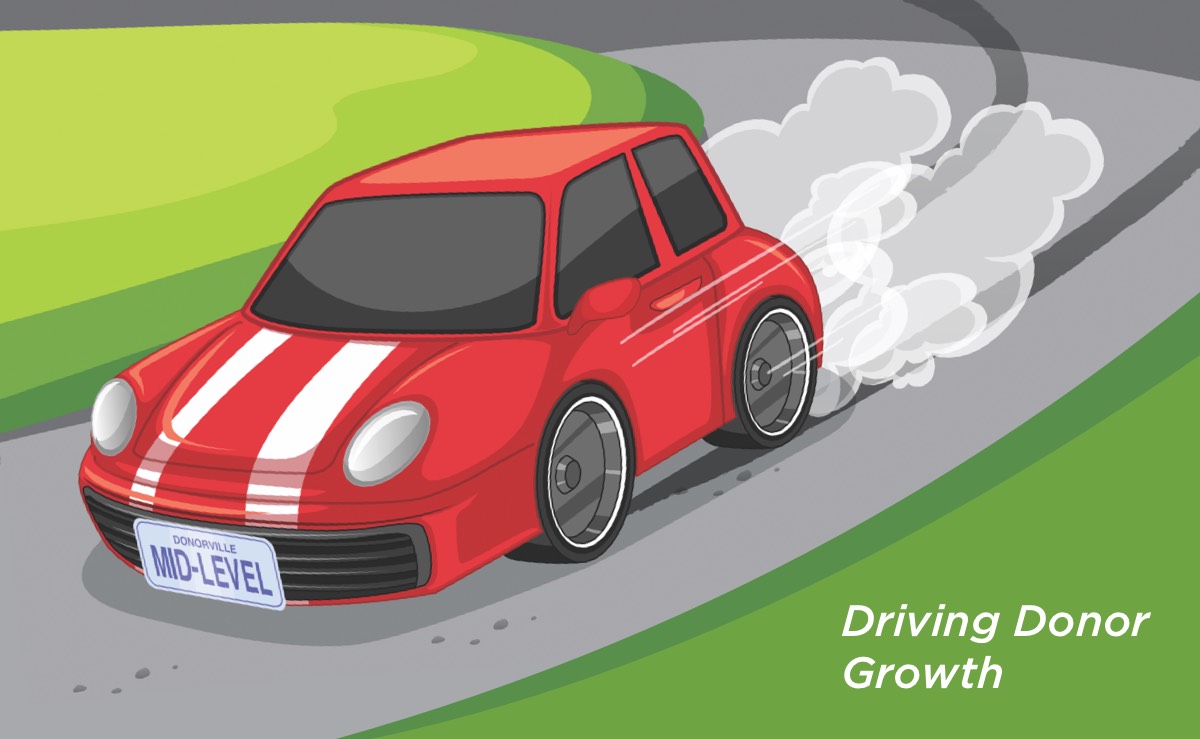Mid-Level Donors: Building Momentum to Fill the Gap

Has the latest Fundraising Effectiveness Project (FEP)* report left your annual giving team scratching their heads? Wringing their hands? Maybe even in tears?
Donor counts are down again … retention is still shrinking … acquisition are rates falling, falling, falling across the nonprofit sector. No wonder the report keeps so many fundraisers up at night.
And yet … there’s that one little detail: overall giving is up. The most recent report shows sector-wide growth of 2.9%.
Once again, mega-donors have carried the day for so many nonprofit organizations.
As direct marketing fundraisers, we can shake our heads and envy the major gift officers with their big wins. Or — as many of my peers in the sector have already discovered — we can get strategic, using every tool at our disposal to find and cultivate the donors who are ready and able to do more.
I’m talking about mid-level donors. They’re the often-overlooked bridge between annual giving and major gifts — and with the right attention, they can become a steady engine of growth. Too often, though, they fall into a “middle child” gap: too large for mass marketing, too small for major gift portfolios. That makes them the most under-leveraged segment in the file.
Strategically define who your mid-level donors are
The most common definition of mid-level donors includes those giving between $1,000 and $10,000. But clarity is key: are we talking about last gift, largest gift, or cumulative annual giving? Establishing a consistent definition early — and doing so in collaboration with major gift officers — ensures alignment and appropriate stewardship.
Major gift officers may personally manage around 100 deep relationships, but well-structured mid-level portfolios can include several hundred donors. These donors are typically managed through coordinated cultivation streams rather than one-on-one attention, balancing personalization with scalability.
Develop a thoughtful program structure
Consider creating a branded mid-level program to make it stand out, but only if the name feels authentic and naturally aligned with your mission — forced cleverness can backfire. Some organizations succeed with a single overarching brand that includes both major and mid-level tiers, allowing flexibility for MGOs to include mid-level donors in select communications. This approach is often more cost-effective for smaller programs.
Tiered levels within a program can encourage upgrades and signal increasing impact, while modest benefits such as insider updates, special recognition, or priority invitations can help donors feel a stronger sense of belonging. It’s also important to understand the donor’s original entry point: a $1,000 acquisition donor may have a very different motivation — and upgrade potential — than a family insider giving the same amount annually.
Identify and qualify new prospects
Identifying the best mid-level prospects requires more than instinct. Wealth screening and predictive modeling can help flag donors with the highest likelihood to upgrade by analyzing recency, frequency, gift size, and engagement behaviors.
However, RFM indicators often outperform wealth data alone — so combining both creates the strongest picture of upgrade readiness.
Be sure to track donor-advised fund (DAF) giving and make the pathway from DAF to direct giving simple and clear. Many organizations are also integrating sustainer data into mid-level modeling, since monthly givers often demonstrate the loyalty and intent that predict successful upgrades.
Elevate donor communications
Mid-level donors should feel a noticeable difference in how they’re communicated with. Higher-touch elements — better paper stock, personalization, and first-class postage — signal importance and care. Distinctive formats like invitation-style envelopes or unusual mail packages can also help your appeals stand out.
Complementing print with digital touchpoints — dedicated landing pages, website features, search engine marketing, and USPS Informed Delivery ride-alongs (when scale allows) — creates a seamless experience across channels. Sustainers should also receive tailored messaging, showing how incremental increases can move them into the mid-level circle without breaking their monthly rhythm.
One important caveat: avoid pulling your strongest membership donors out of their established membership treatment until they’ve given a qualifying mid-level gift or shown clear intent. And above all, maintain consistency. Keeping mid-level donors in your regular direct mail streams — with modest enhancements like hand-signed notes or customized ask strings — helps prevent lapsing and reinforces loyalty.
Strengthen stewardship and collaboration
Stewardship is where mid-level donors truly feel the difference. Prompt, personal acknowledgments are essential — and even a thank-you call after a $100+ gift with no ask attached can build trust and prime donors for future upgrades.
Communicating impact through stories, insider briefings, and small “access experiences” reinforces value and deepens commitment.
Consider inviting mid-level donors to virtual roundtables, behind-the-scenes tours, or quarterly “state of the mission” webinars. Few may attend, but the invitation itself signals importance and connection.
Finally, close coordination with major gift officers ensures smooth donor movement between segments. If a donor stalls in MGO cultivation, reintroducing mid-level strategies can re-engage them. And when a donor upgrades successfully, that’s the moment for the personal connection that only an MGO can provide.
Closing Thought
Today’s mid-level donors already believe in your mission. They’re giving well above your typical annual donor, demonstrating commitment and greater capacity. With a thoughtful, dedicated program and a little extra attention, they can become tomorrow’s major donors — and today’s most reliable champions.
The latest FEP data shows just how tough the environment is. But it also points to where the opportunities lie. It’s up to us to recognize the potential of mid-level donors and invest in them with the care and creativity they deserve.
*The Fundraising Effectiveness Project (FEP) is a joint AFP Foundation/GivingTuesday initiative that provides quarterly sector data.
Like what you read? Check out this related post:
